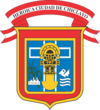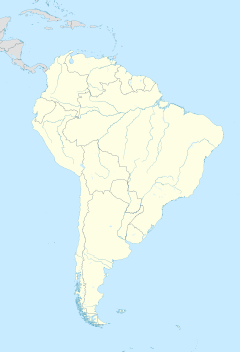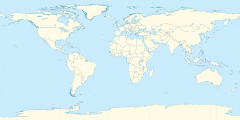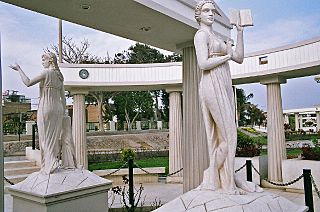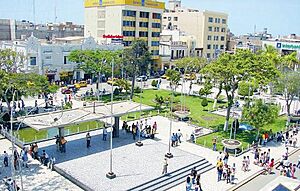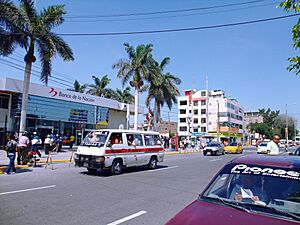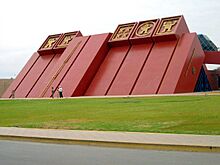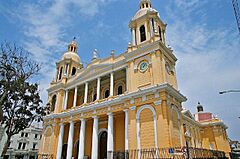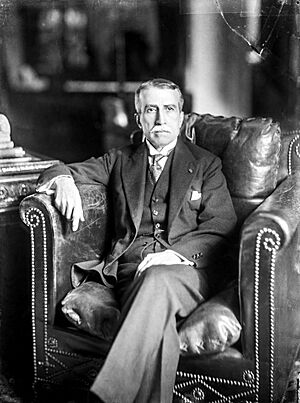Chiclayo facts for kids
Quick facts for kids
Chiclayo
Santa María de los Valles de Chiclayo
|
|||
|---|---|---|---|

Clockwise from top left: Chiclayo Cathedral, also known as Santa María Catedral; statues of the Paseo Yortuque; Walk of the Muses; Basilica of San Antonio de Padua; and Main Park
|
|||
|
|||
| Nickname(s):
City of Friendship
|
|||
| Country | |||
| Region | Lambayeque | ||
| Province | Chiclayo | ||
| District | Chiclayo | ||
| Settled | 18 April 1835 | ||
| Founded by | Felipe Santiago Salaverry | ||
| Government | |||
| • Type | Mayor–council government | ||
| Area | |||
| • City | 174.46 km2 (67.36 sq mi) | ||
| Elevation | 27 m (89 ft) | ||
| Population
(2022)
|
|||
| • City | 609,400 | ||
| • Estimate
(2015)
|
600,440 | ||
| • Rank | 4th | ||
| • Urban density | 5,192/km2 (13,450/sq mi) | ||
| • Metro | 812,548 | ||
| Demonym(s) | Chiclayano | ||
| Time zone | UTC-5 (PET) | ||
| UBIGEO |
14000-14013
|
||
| Area code | 74 | ||
| Website | www.gobiernochiclayo.gob.pe | ||
Chiclayo is a major city in northern Peru. It is the capital of the Lambayeque Region and Chiclayo Province. The city is located about 13 kilometers (8.1 miles) from the Pacific coast. It is also 770 kilometers (480 miles) north of Lima, Peru's capital.
Chiclayo was first settled by Spanish explorers in the 1500s. It was known as "Santa María de los Valles de Chiclayo." It was a small stop for travelers. On April 15, 1835, President Felipe Santiago Salaverry officially declared Chiclayo a city. He called it "the Heroic City" because its people were brave during the fight for independence. Chiclayo is also known as "The Capital of Friendship" and the "Pearl of the North." This is because its people are very kind and welcoming.
Chiclayo is Peru's fourth-largest city. It has a population of over 600,000 people. The wider Chiclayo area, called the Chiclayo metropolitan area, has over 800,000 residents. This makes it the fourth most populated metropolitan area in Peru. The city is divided into three main parts: Chiclayo, La Victoria, and José Leonardo Ortiz. Chiclayo was built near ancient ruins from the Wari Empire. It was also part of the Moche culture a long time ago. The famous Lord of Sipán was a Moche ruler. You can see many Moche artifacts at the Royal Tombs of Sipán Museum in nearby Lambayeque.
Contents
- What Does the Name Chiclayo Mean?
- Symbols of Chiclayo
- A Look at Chiclayo's History
- How Chiclayo is Governed
- Geography of Chiclayo
- People and Population of Chiclayo
- Education and Culture in Chiclayo
- Must-See Sights and Attractions
- Getting Around Chiclayo
- Sister Cities of Chiclayo
- Famous People from Chiclayo
- Images for kids
- See also
What Does the Name Chiclayo Mean?
The name Chiclayo has a few interesting stories behind it.
Stories Behind the Name
- Some say it comes from an old local man. He was known as "chiclayoc" or "chiclayep." He used to carry plaster between old cities.
- Another idea is that the area had a green fruit. This fruit was called chiclayep or chiclayop. In the Mochican language, this meant "green that hangs." Even today, some towns call squashes chiclayos.
- A different source suggests the name comes from the Moche language. It might be from "Cheqta" meaning "half" and "yoc" meaning "property of."
- Others believe it's from Mochican words like Chiclayap or Chekliayok. These words mean "place where there are green branches."
Symbols of Chiclayo
Chiclayo has a special symbol called a coat of arms. It shows important things about the city.
Chiclayo's Coat of Arms
The coat of arms has a light blue background. This represents the Virgin of the Immaculate Conception, a Catholic symbol. It also shows a cross, meaning it is a Catholic town. Other parts of the shield tell about its history and nature.
What the Symbols Mean
- Tumi: This is a special ceremonial knife. It was used by the ancient Lambayeque culture. It represents Naylamp, a legendary figure.
- Sea: The sea has always been very important. It provided food and inspired many old stories.
- Huerequeque: This is a bird typical of the region. It's named after the sound it makes when it sings.
A Look at Chiclayo's History
Chiclayo has a rich history, going back to ancient times.
Ancient Cultures of Chiclayo
The Moche Civilization
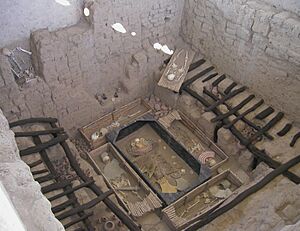
The Moche culture lived here between the 1st and 7th centuries AD. They were very smart engineers. They built canals to water their crops. This helped them grow a lot of food. They also used copper to make tools, weapons, and beautiful decorations. The Moche were one of the biggest and most important groups in Peru. Their ruins, like the Lord of Sipán site, are popular tourist spots.
During Moche times, Pampa Grande, near Chiclayo, was a very important city. The Moche made amazing pottery. Their pots showed religious scenes, people, animals, and myths. They were famous for "huaco-portraits," which are realistic pottery faces. The Moche civilization ended because of natural disasters like El Niño.
The Sican Culture
The Sican culture (also called Lambayeque culture) lived here from 700 to 1375 AD. They took many ideas from the Moche. At their strongest, they covered almost the entire coast of Peru. The Sican people were great at building, making jewelry, and sailing. A long drought around 1020 AD, along with more El Niño events, caused their civilization to decline.
Later, the Chimu Empire took over the Sican lands. The Chimu learned Sican techniques for working with gold and silver. Eventually, the Inca Empire conquered the Chimu. This made the region part of the Inca empire until the Spanish arrived.
Chiclayo in Colonial Times
In the early 1500s, two local groups lived in Chiclayo. Their leaders gave land to build a Franciscan church and convent. This was approved in 1585. So, a church and convent were built, and the city of Chiclayo began. Unlike other big Spanish cities in Peru, Chiclayo was mostly home to native people, not Spanish settlers.
The Spanish explorer Francisco Pizarro passed through the Chiclayo region. He was on his way to meet the Inca emperor, Atahualpa. Chiclayo was part of a large area called the Intendancy of Trujillo. This area covered most of northern Peru.
Chiclayo's Republican Era
During the Peruvian War of Independence, Chiclayo helped a lot. Its people provided soldiers, weapons, and horses. This was led by patriots like José Leonardo Ortiz.
After Peru became independent, Chiclayo was still a small village. On April 15, 1835, President Felipe Santiago Salaverry officially made Chiclayo a city. He called it a "Heroic City" for its help in the war. The next day, the Chiclayo Province was formed, with Chiclayo as its capital.
Modern Chiclayo Today
Today, Chiclayo is a very important city in Peru. It is a major center for money and business in northern Peru. Its location makes it a key spot for travel and communication. The city has modern supermarkets, banks, hospitals, and shops. There are also plans for a new train line, the Tren de la Costa. This train would connect Chiclayo to other cities.
Chiclayo is still known as the "City of Friendship" and the "Pearl of the North." This is because of its friendly people.
How Chiclayo is Governed
Chiclayo is led by a mayor. The mayor is chosen by the people every four years. Each smaller part of the city, called a district, also has its own mayor. These district mayors work with the main mayor of Chiclayo. The current mayor of Chiclayo is Janet Cubas Carranza.
Districts of Chiclayo
Central Chiclayo includes three main districts: Chiclayo, José Leonardo Ortiz, and La Victoria. Around these central areas are three more districts: Pimentel, Pomalca, and Reque. These districts cover a total area of about 252 square kilometers (97 square miles).
Chiclayo's Metropolitan Area
Chiclayo is part of a larger "metropolitan area" with nearby cities. This area includes the six districts of Chiclayo. It also includes six other places like Lambayeque and Santa Rosa. Many people in these nearby areas live there and work in Chiclayo.
Geography of Chiclayo
Where is Chiclayo Located?
Chiclayo is located 13 kilometers (8.1 miles) from the Pacific Ocean. It is 208 kilometers from Trujillo and 770 kilometers (480 miles) from Lima. The city is 27 meters (89 feet) above sea level. Like Trujillo, Chiclayo has great surfing spots. Pimentel is the most popular beach.
Chiclayo's Climate
Chiclayo has a warm and very dry desert climate. The sun shines almost all year. Even though it's near the Equator, the weather is usually comfortable and dry. This is because of strong winds that keep temperatures moderate.
In summer (December to May), it's hot, from 27 °C to 30 °C (81 °F to 86 °F) during the day. Nights are between 19 °C to 21 °C (66 °F to 70 °F). Sometimes, it can reach 33 °C (91 °F) in February and March. This makes it a great place for beach resorts like Puerto Eten and Pimentel.
Winter (July to September) is milder. Daytime temperatures are 21 °C to 24 °C (70 °F to 75 °F). It's less humid than other coastal cities in Peru. Every few years, during the El Niño phenomenon, temperatures can go above 35 °C (95 °F). There can also be heavy rains then.
| Climate data for Chiclayo (1961–1990, extremes 1943–present) | |||||||||||||
|---|---|---|---|---|---|---|---|---|---|---|---|---|---|
| Month | Jan | Feb | Mar | Apr | May | Jun | Jul | Aug | Sep | Oct | Nov | Dec | Year |
| Record high °C (°F) | 36.2 (97.2) |
38.0 (100.4) |
36.0 (96.8) |
39.2 (102.6) |
34.9 (94.8) |
34.7 (94.5) |
35.4 (95.7) |
31.4 (88.5) |
30.5 (86.9) |
30.0 (86.0) |
32.2 (90.0) |
34.0 (93.2) |
39.2 (102.6) |
| Mean daily maximum °C (°F) | 29.1 (84.4) |
30.5 (86.9) |
30.3 (86.5) |
28.8 (83.8) |
26.6 (79.9) |
24.9 (76.8) |
23.6 (74.5) |
23.4 (74.1) |
23.6 (74.5) |
24.2 (75.6) |
25.3 (77.5) |
27.1 (80.8) |
26.4 (79.5) |
| Daily mean °C (°F) | 23.4 (74.1) |
24.3 (75.7) |
24.3 (75.7) |
22.8 (73.0) |
21.1 (70.0) |
19.9 (67.8) |
18.8 (65.8) |
18.4 (65.1) |
18.3 (64.9) |
18.8 (65.8) |
19.7 (67.5) |
21.8 (71.2) |
21.0 (69.8) |
| Mean daily minimum °C (°F) | 19.3 (66.7) |
20.5 (68.9) |
20.5 (68.9) |
19.1 (66.4) |
17.8 (64.0) |
16.7 (62.1) |
15.7 (60.3) |
15.3 (59.5) |
15.2 (59.4) |
15.6 (60.1) |
16.3 (61.3) |
17.6 (63.7) |
17.5 (63.5) |
| Record low °C (°F) | 15.0 (59.0) |
16.0 (60.8) |
10.5 (50.9) |
12.8 (55.0) |
11.0 (51.8) |
12.8 (55.0) |
12.0 (53.6) |
11.0 (51.8) |
12.0 (53.6) |
12.0 (53.6) |
10.0 (50.0) |
10.0 (50.0) |
10.0 (50.0) |
| Average precipitation mm (inches) | 5.9 (0.23) |
2.4 (0.09) |
8.8 (0.35) |
4.0 (0.16) |
1.3 (0.05) |
0.4 (0.02) |
0.0 (0.0) |
0.3 (0.01) |
0.6 (0.02) |
0.8 (0.03) |
1.9 (0.07) |
0.5 (0.02) |
26.9 (1.06) |
| Average precipitation days (≥ 1.0 mm) | 1.2 | 1.3 | 3.6 | 1.9 | 0.7 | 0.3 | 0.0 | 0.2 | 0.2 | 0.4 | 0.3 | 0.6 | 10.6 |
| Average relative humidity (%) | 73 | 72 | 74 | 75 | 76 | 78 | 79 | 80 | 79 | 79 | 78 | 76 | 77 |
| Source 1: NOAA, Meteo Climat (record highs and lows) | |||||||||||||
| Source 2: Deutscher Wetterdienst (mean temperatures 1961–1990, precipitation days 1970–1990 and humidity 1954–1969) | |||||||||||||
People and Population of Chiclayo
In 2007, about 574,408 people lived within Chiclayo's city limits. The larger metropolitan area had 930,824 people. This area includes nearby cities like Monsefú and Lambayeque. Chiclayo is in a very fertile valley. It is the fourth largest city in Peru.
Education and Culture in Chiclayo
Universities in Chiclayo
Chiclayo has many universities where students can continue their education:
- Catholic University of Santo Toribio de Mogrovejo
- Private University of Juan Mejia Baca
- Señor de Sipan University
- Private University of Chiclayo
- University of Lambayeque
- San Martín de Porres University
- César Vallejo University
- Alas Peruanas University
- Federal Republic of Germany Institute
- Senati, National Industrial Training Service
Museums to Explore
Chiclayo is famous for its museums. The most well-known is the Royal Tombs of Sipán Museum. It is in the city of Lambayeque, which is part of the Chiclayo area. This museum has amazing artifacts from the ancient Moche culture.
Here are some museums in the area:
- Huaca Rajada – Sipan Museum
- Royal Tombs of Sipan Museum
- Sican National Museum
- Hans Heinrich Bruning National Museum
- Museum of Valley of the Pyramids of Tucume
- On Site Museum in Sipán (the newest and smallest museum)
Delicious Food in Chiclayo
The Department of Lambayeque and Chiclayo are known for their tasty food. Two popular dishes are:
- Chiclayo Arroz con pato: This means "rice with duck." It's a spicy and tangy dish. The duck is marinated in garlic and vinegar.
- Abrito a la norteña: This dish is served with cooked Yucca, lamb, rice, and beans.
- Loche de Lambayque: Also called pumpkin loche, this is a special fruit. It has been grown in Chiclayo since ancient times.
Sports in Chiclayo
Association football, or soccer, is the most popular sport here. Chiclayo's most famous soccer team is Juan Aurich. They won the Peruvian championship in 2011. Other teams include FC Carlos Stein and Pirata FC.
Chiclayo's main stadium is Estadio Elías Aguirre. It can hold 24,500 people. It has hosted big events like the 2004 Copa América and the 2005 FIFA U-17 World Championship. Other popular sports in Chiclayo are Volleyball, Basketball, and Rugby.
Must-See Sights and Attractions
The Lambayeque region is a great place for tourists. It was home to the ancient Moche civilization. They created amazing monuments and art. In 1987, royal tombs of Moche rulers were found. The treasures from these tombs are now in the Royal Tomb of Sipan Museum. You can also visit the Brunning Museum and the Sicán Museum. These museums show off the beautiful ancient artwork.
The pyramids of Túcume are also in this area. There are over 20 adobe pyramids, each about 40 meters (130 feet) tall. The area is full of plants and wildlife. The Chaparrí Ecological Reserve is also nearby. It has many different kinds of animals and plants.
Here are some popular places to visit in Chiclayo:
- Main Park – This park is in the center of Chiclayo. It has a special fountain with three water jets that form the flag of Peru. Around the park, you'll find shops, the cathedral, and old buildings. It's a great place for tourists and locals to relax.
- Cathedral of Chiclayo –
This beautiful church is in the main square. It was designed in 1869 by Gustave Eiffel, who also designed the Eiffel Tower. The cathedral has tall steeples and a lovely inside. It was finished around 1945, and its bells were added in 1961.
- Municipal Palace – This elegant building was finished in 1924. It used to be the city hall. It has large windows and iron gates. It was damaged by a fire in 2006 but has been restored. Now, it's used as a museum and for special city events.
- La Verónica's Chapel – This chapel was built in the late 1800s. It was named a National Historical Monument in 1987. Its altars are covered with gold and silver.
- Basilica San Antonio – This church has a modern design from 1949. It has a large main hall with arches. A special wooden sculpture of Christ is at the altar.
- Elías Aguirre Square – This square was the first thing travelers saw when they arrived by train. It has a statue honoring Commander Elias Aguirre. He was a hero from Chiclayo in a battle in 1879.
- Municipal Library José Eufemio Lora y Lora – This is one of the largest libraries in Peru. However, it needs more books and modern services like internet.
- Centro Cívico – Civic Center – This area used to be a railway station. Now, it has important government buildings. These include the post office, banks, and courts.
- Parque Infantil – Children Park – This is the largest and oldest park in the city. It has many play areas and a big stage for outdoor shows. It also has different plant species from all over the world.
Getting Around Chiclayo
Air Travel
The FAP Captain José Abelardo Quiñones González International Airport (CIX) is Chiclayo's main airport. It handles flights for Chiclayo and the surrounding area. Several airlines fly here, offering domestic flights to Lima. In 2016, Copa Airlines started direct international flights to Panama. This was the first international flight to the city. Star Perú also added flights to Tarapoto and Iquitos in 2023.
Land Travel
Chiclayo is a central point for travel in northeastern Peru. Many bus companies connect Chiclayo to cities like Lima, Trujillo, Piura, and Cajamarca.
The city has two main bus terminals. One is in the south, and another is in the north on the Panamerican Highway. Many bus companies also have their own terminals downtown. This can cause traffic jams. The city plans to build a central bus station to help with this.
For travel within the region, there are smaller public vehicles. These include combis, cousters, and colectivos. There are also many private taxis. They often honk their horns, which can be noisy.
Sister Cities of Chiclayo
Chiclayo has special friendships with other cities around the world. These are called "twin towns" or "sister cities."
Famous People from Chiclayo
Many notable people have come from Chiclayo:
- José Quiñones Gonzales: A national hero of aviation. He was born in Pimentel, near Chiclayo, in 1914. He became an Air Force pilot. During a conflict with Ecuador, he crashed his plane into an enemy target instead of parachuting to safety.
- Augusto Bernardino Leguía y Salcedo: He was the President of Peru for several terms (1908–1912 and 1919–1930). He ruled for a total of 15 years, which is the longest time any Peruvian president has served.
- Luis Castañeda Lossio: A Peruvian lawyer and politician. He served as the Mayor of Lima from 2005 to 2010 and again starting in 2015.
- Gerardo Pastor Boggiano: A visionary mayor of Chiclayo from 1970 to 1974. He helped expand roads and rebuilt parts of the city. He also started building the Civic Center and the Municipal Library.
- Yehude Simon Munaro: A Peruvian veterinarian, sociologist, and politician. He served as the Prime Minister of Peru from 2008 to 2009.
- Velásquez Quesquén: A lawyer and politician. He was the head of Congress and Prime Minister of Peru from 2009 to 2010.
- Tania Libertad: An internationally famous singer.
Images for kids
See also
 In Spanish: Chiclayo para niños
In Spanish: Chiclayo para niños



